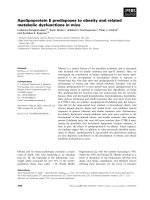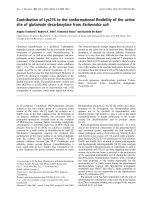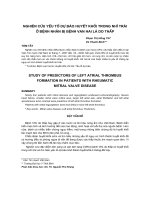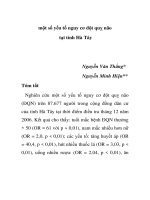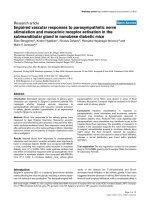Báo cáo y học: " Exercise augmentation compared to usual care for Post Traumatic Stress Disorder: A Randomised Controlled Trial (The REAP study: Randomised Exercise Augmentation for PTSD)" ppt
Bạn đang xem bản rút gọn của tài liệu. Xem và tải ngay bản đầy đủ của tài liệu tại đây (244.34 KB, 7 trang )
STUDY PROTO C O L Open Access
Exercise augmentation compared to usual care
for Post Traumatic Stress Disorder: A Randomised
Controlled Trial (The REAP study:
Randomised
Exercise Augmentation for PTSD)
Simon Rosenbaum
1,2*
, Dang Nguyen
1
, Tom Lenehan
1
, Anne Tiedemann
2
, Hidde P van der Ploeg
3
and
Catherine Sherrington
2
Abstract
Background: The physical wellbeing of people with mental health conditions can often be overlooked in order to
treat the primary mental health condition as a priority. Exercise however, can potentially improve both the primary
psychiatric condition as well as physical measures that indicate risk of other conditions such as diabetes mellitus
and cardiovascular disease. Evidence supports the role of exercise as an important component of treatment for
depression and anxiety, yet no randomised controlled trials (RCT’s) have been conducted to evaluate the use of
exercise in the treatment of people with post traumatic stress disorder (PTS D).
This RCT will investigate the effects of structured, progressive exercise on PTSD symptoms, functional ability, body
composition, physical activity levels, sleep patterns and medication usage.
Methods and design: Eighty participants with a Diagnostic and Statistical Manual of Mental Disorders (DSM-IV)
diagnosis of PTSD will be recruited. Participants will have no contraindications to exercise and will be cognitively
able to provide consent to participate in the study.
The primary outcome measures will be PTSD symptoms, measured through the PTSD Checklist Civilian (PCL-C)
scale. Secondary outcome measures will assess depression and anxiety, mobility and strength, body composition,
physical activity levels, sleep patterns and medication usage. All outcomes will be assessed by a health or exercise
professional masked to group allocation at baseline and 12 weeks after randomisation.
The in tervention will be a 12 week individualised program, primarily involving resistance exercises with the use of
exercise bands. A walking component will also be incorporated. Participants will complete one supervised session
per week, and will be asked to perform at least two other non-supervised exercise sessions per week. Both
intervention and control groups wi ll receive all usual non-exercise interventions including psychotherapy,
pharmaceutical interventions and group therapy.
Discussion: This study will determine the effect of an individualised and progressive exercise intervention on PTSD
symptoms, depression and anxiety, mobility and strength, body composition, physical activity levels, sleep patterns
and medication usage among people with a DSM-IV diagnosis of PTSD.
Trial Registration: ACTRN12610000579099
* Correspondence:
1
St John of God Healthcare, Richmond Hospital 177 Grose Vale Rd North
Richmond, NSW 2754, Australia
Full list of author information is available at the end of the article
Rosenbaum et al. BMC Psychiatry 2011, 11:115
/>© 2011 Rosenbaum et al; licensee BioMed Central Ltd. This is an Open Access article distrib uted under the terms of the Creat ive
Commons Attribu tion License ( which permits unrestricted use, distribution, and
reproduction in any medium, provided the original work is properly cited.
Background
Mental health consumers typical ly have poorer health
outcomes than people of a comparable age without
mental health issues and are more likely to have meta-
bolic conditions such as diabetes, hypertension and
hypercholesterolemia [1]. Regular exercise has been
shown to positively impact upon factors contributing to
the metabolic syndrome as well as improving depressive
and anxiety related symptoms [2-4]. Despite these find-
ings, and the potential ‘ double impact’ that regular exer-
cise may have on conditions such as PTSD, mental
health consumers are less likely to embark on and
adhere to a regular exercise program [5].
In order to maintain health and reduce the risk of
chronic disease, the American College of Sports Medicine
(ACSM) recomme nds adults perform moderately intense
cardio-respiratory based physical activity for 30 minutes a
day, five days a week, or alternatively perform vigorously
intense cardio-respiratory based exercise 20 minutes a day,
3 days a week in addition to performing eight to 10
strength-training exercises, with eight to 12 repetitions of
each exercise twice a week [2]. When prescribing exercise
for mental health consumers such as those with PTSD,
meeting the ACSM guidelines should be the ultimate aim.
However ensuring engagement with the program regard-
less of how minimal it may be is likely to be rudimentary
to its success, and can allow for progressions to be made
as the parti cipants become more confident and adherent
to the program.
PTSD affects an estimated 5% of Australians, with
hyperarousal, re-experiencing and avoidance the main
symptom clusters [6]. Depression, anxiety, drug and alco-
hol addiction and sleep disturbance are common psychia-
tric comorbidities [6]. Treatment modalities include
medications, cognitive behavioral therapy, psychody-
namic psychotherapy, eye movement desensitization and
reprocessing (EMDR) and group psychotherapy. Evi-
dence-based treatment for PTSD is still quite limited and
there is no definitive evidence to guide pharmacological
prescription. The International Consensus Group on
Depression and Anxiety recommends selective serotonin
reuptake inhibitors (SSRIs) and exposure therapy [6].
The 2007 Australian Guidelines for the Treatment of
Adults with Acute Stress Disorder and Post Traumatic
Stress Disorder state that exercise may be helpful in
managing symptoms and as part of self-care more gener-
ally [7], but the clinical guid elines note that no studies
have examined the effectiveness of exercise as an adjunct
to other PTSD treatments.
At the time of writing, no randomised controlled trial
(RCTs) had been conducted investigating the effects of
an individualized and structured exercise program on
patients with a DSM-IV diagnosis of PTSD [7,8]. A
2010 Cochrane Collaboration review titled ‘ Sports and
games for post-traumatic stress disorder found that no
RCTs had been conducted to assess the effect of sports
or game based i nterventions on symptoms of PTSD [8].
Although the review identified five studies, none met
the inclusion criteria as they were not randomised con-
trolled trials [9], participants were not diagnosed with
PTSD or a psychological based intervention was tested
such as play-therapy [10,11].
Some evidence of the potential benefit of exercise on
PTSD sympt oms comes from a 2008 study by Diaz and
Motta [12]. They conducted a non-randomised study
involving twelve female adolescents diagnosed with
PTSD. Their results showed that 91% of participants
showed a significant reduction in PTSD symptoms on
the Childhood PTSD Symptom Scale, following partici-
pation in a walking program [12]. The study had a num-
ber of limitations including the use of a low intensit y
exercise protocol which did not include progressive
overload training, and failed to incorporate a ny of the
ACSM guidelines regarding exercise prescription. Given
the potential impact on both the PTSD symptoms and
physical co-morbidities, there is a compelling need for
an evidence-based approach to prescribing exercise for
people diagnosed with PTSD.
The current RCT will investigate the effects of struc-
tured, progressive exercise on PTSD symptoms, depres-
sion and anxiety, mobility and strength, body composition,
physical activity levels, sleep patterns and medication
usage among people with a DSM-IV diagnosis of PTSD.
Methods/design
Design
An assessor-blinded RCT will be conducted. A total of 40
participants in each group (n = 80) will be recruited. The
study will have 80% pow er to detect as significant at the
5% level a 5 point between group difference on the PCL-C
(SD = 9.4) [13] allowing 15% dropouts. The study protocol
has been designed and will be reported, with reference to
the CONSORT Statement [14]. Figure 1 gives an overview
of the study design.
Participants
Participants will be consenting people aged over 18
years with a DSM-IV diagnosis of primary PTSD. The
study sample will consist of patients from St John of
God He althcare’s Richmond Hospital, located in Sydney,
Australia. To be eligible for study inclusion, participants
must be considered medically fit to participate in an
exercise program by the consulting medical officer. All
participants must be cognitively able to provide consent.
People will be ineligible to participate in the trial if
they are medically unfit to participate, are pregnant or
Rosenbaum et al. BMC Psychiatry 2011, 11:115
/>Page 2 of 7
planning pregnancy within the next year and if they are
diagnosed with complex PTSD with trauma occurring in
childhood only.
Ethical considerations
Full ethical approval for this study has been obtained
from St John of God Healthcares Ethical Committee
(REF: 412). Written informed consent from all partici-
pants will be obtained prior to the baseline assessment.
The research team will be advised by nursing and/or
medical staff as to whether potential participants are
cognitively able to provide consent.
Randomisation
Upon admission to the hospital a s either an in-patient
or out-patient, a routine physical assessment will be
conducted by a consulting medical officer to assess trial
eligibility based on physical limitations. This initial
assessment will also be used to confirm that the poten-
tial participant meets the DSM-IV diagnosis of PTSD.
Eligible subjects will then be invited to participate in the
trial by the research team. Posters, flyers and other mar-
keting material will be distributed around the facility to
promote awareness of the trial. Outpatients eligible to
part icipate will be informed of the study through hospi-
tal s taff at various times throughout their contact with
the hospital.
Once consent has been obtained, the baseline assess-
ment will be conducted and participants will then be
randomised to either the exercise i ntervention or con-
trol group. Allocation to groups will be undertaken by
a staff member not involved in recruitment (to ensure
allocation concealment) using a block randomisation
sequence generated using random numbers in Excel
and including randomly varying block sizes. Partici-
pants and intervention staff are unable to be blinded
to group allocation, but health and exercise profes-
sionals assessing all outcome measures will be blinded
to group allocation.
Intervention
The exercise inte rvention will comprise a minimum of
three exerci se sessions per week, with one session com-
pleted at the hospital under supervision of an e xercise
physiologist and the other two completed without
supervision. All required exercise equipment will be
supplied to participants for the duration of the study.
The exercise protocol consists of a series of progressive
compound exercises using exercise bands and body
weight for resistance. Particip ants will perform 3 sets of
10 repetitions of each exercise. A warm-up set that is
one intensity level below the ‘overload sets ’ will also be
included. A rest period of between 10 and 30 seconds
will be allowed between sets. Once exercise technique is
considered competent b y the exercise physiologist or
research nurse, participants will be advised to perform
all exercises in a circuit like manner, adding a cardio-
respiratory component to the exercise sessions. Exer-
cises are outlined in Table 1.
Each exercise session with the exercise physiologist
will last for approximately 30 minutes. Sessions will be
predominantly one-on-o ne, however during the later
stages of the intervention it is expected that up to
three participants could be present in a single exercise
session.
During the initial exercise session, results from the
physical assessment, International Physical Activity
Questionnaire(IPAQ)[15]andtheBorgRatingofPer-
ceived Exertion Scale (RPE) [16] will be used to assign
the initial pro gram intensity from the Randomised Exer-
cise Augmentation for PTSD (REAP) exercise table. It is
expected that most of the cohor t will be sedentary at the
time of re cruitment so exercises will be introduced in a
staged manner in order to max imise adherence and tech-
nique acquisition. The REAP exercises have been
ĚŵŝƐƐŝŽŶƚŽĨĂĐŝůŝƚLJ
љ
WŚLJƐŝĐĂůĂŶĚƉƐLJĐŚŝĂƚƌŝĐĞdžĂŵŝŶĂƚŝŽŶ
љ
/ŶŝƚŝĂůĐŽŶƚĂĐƚďLJƌĞƐĞĂƌĐŚƚĞĂŵ
љ
ŽŶƐĞŶƚƚŽƉĂƌƚŝĐŝƉĂƚĞ
љ
ĂƐĞůŝŶĞĂƐƐĞƐƐŵĞŶƚ
љ
ZĂŶĚŽŵŝƐĂƚŝŽŶ
ѝќ
džĞƌĐŝƐĞĂƵŐŵĞŶƚĂƚŝŽŶ hƐƵĂůĐĂƌĞĐŽŶƚƌŽů
љ
tĞĞŬůLJĞdžĞƌĐŝƐĞƐĞƐƐŝŽŶƐ
љ
WŽƐƚŝŶƚĞƌǀĞŶƚŝŽŶĂƐƐĞƐƐŵĞŶƚ
dŝŵĞůŝŶĞ
tĞĞŬϬ
tĞĞŬƐϭͲϭϮ
tĞĞŬϭϮ
Figure 1 Flow of participants through the trial.
Rosenbaum et al. BMC Psychiatry 2011, 11:115
/>Page 3 of 7
segmented into ‘Key’, ‘Secondary’ and ‘Additional’ exer-
cises indicating the order in which they will be intro-
duced into the program. Individual limitations such as
arthritic conditions, skill and co ordination will also be
considered when prescribing the exercises. For example
if a participant is able to perform ten repetitions of the
Level 1 chest press with an RPE b elow 12/20 (indica ting
light exertion), then the Level 2 progression will be
attempted. Di scretion will be used when apply ing the
RPE scale. The weekly exercise sessions with the exercise
physiologist/research nurse w ill be used to address any
issues that participants may have with exercise technique,
exercise progressions and adherence.
In addition to the resistance exercise program, a walk-
ing program will be included. Participants randomised to
the intervention group will be provided with an Omron
HJ109 pedometer in order to quantify daily step count.
Partic ipants will be asked to record their daily step count
on the exercise diaries provided and the results of which
will be used to assist with goal setting and motivation.
Participants will be encouraged to aim for an ultimate
daily target of 10,000 steps per day [17] which can be
broken down into a series of short and incidental walks,
in order to maximise feasibility and adherence.
Participants in the exercise group will also receive
usual treatment for PTSD involving a combination of
psychotherapy, pharmaceutical interventions and group
therapy facilitated by psychologists. Voluntary programs
including yoga, art therapy and use of the hospital gym-
nasium will also be available.
Motivational Tools
Defined behaviour change techniques (BCT’ s) such as
barrier identification, general encouragement, setting of
graded tasks, instruction, specific goal setting, self-moni-
toring and feedback will be incorporated into the inter-
vention program to enhance engagement and uptake of
the intervention [18]. Exercise diaries and motivational
interviewing will be a major component of the BCT’ s
used. As recommended by the National Institute for
Health and Clinical Excellence (NICE) 2007 guidelines
on behaviour change at populatio n, community and
individual levels [19], the exercise physiologist and
research nurse will use a combination of strategies to
increase physical activity participation. Structured strate-
gies to overcome common barriers to exercise will also
be used. These strategies can be found in Table 2 [20].
Exercise diaries i n the form of a printed spread-sheet
will be provided and participants will be encouraged to
record the date, time, number of sets and repetitions
performed, and amount of walking done per day (mea-
sured with a pedometer). The diaries will also be used
to guide progression of the intensity of individual exer-
cise programs.
Control Group
The control group will receive usual care, which will
involve a combination of ps ychotherapy, pharmaceutical
interventions and group therapy facilitated by psycholo-
gists. Access to these treatments by both the control
and intervention groups will be recorded through use of
Table 1 REAP Exercise Chart showing exercises and progression of intensity for each exercise
Exercise Level 1 Level 2 Level 3 Level 4 Level 5 Level 6 Level 7
1
Chest press EB* ‘light’ EB ‘medium’ EB ‘heavy’ EB ‘extra
heavy’
Incline push-
ups
Knee push
ups
Push ups
1
Row EB ‘light’ EB ‘medium’ EB ‘heavy’ EB ‘extra
heavy’
1
Squats Seated leg press
(single leg)
Sit-to-stand squats EB ‘light’ EB ‘medium’ EB ‘heavy’ EB ‘extra
heavy’
1
Core/mid section Wall hold 4-point
kneeling
4-point kneeling with
resistance
Prone hold
2
Lat/overhead pull-
down
EB ‘light’ EB ‘medium’ EB ‘heavy’ EB ‘extra
heavy’
2
Upright row EB ‘light’ EB ‘medium’ EB ‘heavy’ EB ‘extra
heavy’
3
Bicep curl EB ‘light’ EB ‘medium’ EB ‘heavy’ EB ‘extra
heavy’
3
Triceps extension EB ‘light’ EB ‘medium’ EB ‘heavy’ EB ‘extra
heavy’
Chair dips
3
Leg extensions Body weight (single
leg)
EB ‘light’ EB ‘medium’ EB ‘heavy’ EB ‘extra
heavy’
*EB exercise band.
1
Indicates ‘Key Exercise’.
2
Indicates ‘Secondary Exercise’.
3
Indicates ‘Additional Exercise’.
Rosenbaum et al. BMC Psychiatry 2011, 11:115
/>Page 4 of 7
the hospital database and patient files. Voluntary pro-
grams including yoga, art therapy and use of the hospi -
tal gymnasium will also be available. Access to the
hospital exe rcise program is determined by the consul t-
ing medical physicians and the exercise physiologist.
The control group will be asked to limit their participa-
tion in any exercise program that they do not usually
undertake, however access to the usual hospital exercise
program will not b e restricted for the purpose of this
research. The hospital exercise program involves two,
one hour sessions per week in which patients have
access to the gymnasium and an exercise physiologist.
Equipment available includes treadmills, exercise bands
and a limited number of machine weights. Self-initiated
use of the hospital exercise program by in-patients with
PTSD is usually limited, and it is not e xpected that this
would have significant ramifications for the research.
Participants randomised to the control group who wish
to exercise will be permitted under the usual policy of
the hospital, and participation will be mo nitored and
recorded.
Outcomes
Data Collection
Data will be collected from clinician interviews, self-
report questionnaires, exercise, medication use and sleep
diaries, and physical assessments. Health or exercise
professionals collecting data will be blinded to group
allocation. Physical assessments will be carried out at
baseline, and following the 12 week intervention. All
tests will be conducted in an examination room at the
hospital. Assessments will take approximately 30 min-
utes to administer. All assessments will be carried out
by an assessor blinded to group allocation.
Outcome measures
Post Traumatic Stress Disorder symptoms
The p rimary aim of this study is to examine the effects
of individualised, structured exercise on PTSD
symptoms. This will be measured using the PTSD
Checklist-Civilian [21], a self-report questionnaire com-
prising 17 items relating to the main symptoms of
PTSD. Participants are asked to indicate how much they
have been bothered by a particular symptom over the
past month using a 5-point (1-5) scale.
Depression and Anxiety
The Depression Anxiety and Stress Scale (DASS) [22]
will be used to assess the effects of the program on
depressive and anxiety symptoms. T he DASS is a 42-
item self report instrument that measures the related
negative emotional states of depression, anxiety and ten-
sion/stress.
Mobility, Fitness and Strength
Assessments of mobility will include tests of standing
balance [23] (tandem, semi-tandem and single-leg stance
time), the ability to rise from a chair, and the 6-minute
walk test [24]. Upper limb strength will be assessed
using a hand grip dynamometer with a single assess-
ment to be carried out on each upp er limb [25]. Knee
extension strength will be assessed with a spring gauge
attached to the participant’slegusingawebbingstrap
with a Velcro fastener. The partici pant will extend their
knee pulling against the strap with maximal force for 2-
3 seconds with each leg to be tested 3 times and the
best score recorded [26].
Body Composition
Measurements will include resting heart rate, blood pres-
sure, weight, height, body mass index, body fat percentage
(to be obtained using a Tanita bio-impedance scale), waist
circumference (defined as the point midway between the
iliac crest and costal margin) and hip circumference
(defined as the widest part of the gluteal region).
Physical Activity Levels
Physical activity participation will be measured the short
version of the IPAQ [15]. The IPAQ (short form)
includes 7 questions relating to the amount of time
spent per week engaging in vigor ous and moderate ph y-
sical activity, walking and sedentary activities.
Table 2 Methods of improving behaviour change and overcoming barriers to exercise participation [19,20]
Ensure participants have an understanding of the short, medium and longer-term consequences of their health-related behaviours, for themselves
and others
Assist participants to plan their behaviour changes in terms of easy steps over time
Recognise how social contexts and relationships may affect behaviour, and identify and plan for situations that might undermine changes being
made
Plan explicit ‘if-then’ coping strategies to prevent relapse
Assist participants to make a personal commitment to adopt health-enhancing behaviours by setting (and recording) goals to undertake clearly
defined behaviours, in particular contexts, over a specified time
Share their behaviour change goals with others
Encourage short bouts of exercise for participants with a ‘lack of time’
Encourage group exercise sessions for participants with low motivation
Encourage moderate level activities if physical limitations are present
Rosenbaum et al. BMC Psychiatry 2011, 11:115
/>Page 5 of 7
Sleep Patterns
Sleep habits and patterns including amount of sleep
hours per night and barriers to sleep will be monitored
throug h the Pittsbu rgh Sleep Quality Index [27] and the
Pittsburgh Sleep Quality Index Addendum for PTSD
[28]. Both instruments are self-report questionnaires
that assess sleep quality in the past month.
Medication Usage
Pro re nata (PRN) medication usage specifically sleeping
and as r equired psychotropic medica tion will be mea-
sured using a weekly self-report diary, and patient notes
whilst admitted as an inpatient.
Statistical analysis
Regression models will be used to assess the effect of
group allocation on the primary and secondary outcome
measures after adjusting for baseline values. An inten-
tion-to-treat approach will be used for primary analyses.
A secondary per-protocol analysis will be conducted
excluding people who do not comply with the interven-
tion, defined as performing less than 30% of the recom-
mended exercise sessions. A further secondary analysis
will assess whether there is an interaction between base-
line physical activity levels and group allocation. Analyses
will be conducted using the SPSS and Stata software
packages.
Discussion
The REAP study has been designed to fill a gap in the
current scientific literature regarding the role of exercise
augmentation for the treatment of PTSD. The study
desi gn will evaluate the dual role that exercise may play
in both improving mental health outc omes, and improv-
ing overall cardio-metabolic risk and physical capacity.
The exercise protocol being trialed has been designed
over a 12 month period through ongoing clinical exercise
prescription and supervision with PTSD patie nts at St
John of God Healthcare’s Richmond hospital. The authors
(program designers) have backgrounds in medicine, nur-
sing, exercise science, epidemiology and physiotherapy.
The protocol evolved from the need for a constant balance
between assisting patients to engage in an exercise pro-
gram, whilst making it achievable and affordable and able
to be self-managed. Exercise bands have been selected as
they provide an affordable, portable and safe alternative to
traditional weights to progress exercise intensity. The
assessments of physical abilities included in this trial were
selected to be feasible for the research clinicians to con-
duct in addition to a psychiatric and physical examination
within a constrained time period.
This study will determine the role of exercise augmen-
tation for the treatment of primary PTSD. The results of
this study will determine if an exercise program can be
successfully implemented among people with PTSD. It
will also provide a structur ed exerci se protocol that can
be replicated in other psychiatric facilities. This study
may have implications for the perceived importance of
cli nica l exercise within mainstream psychiatric facilities,
and has the potential to lead to greater investment in
the physical wellbeing of people with mental health
conditions.
Acknowledgements
The authors would like to acknowledge Paul Sawaqed from Workout World
Bankstown for generously providing the required exercise and assessment
equipment. Associate Professor Sherrington and Dr Tiedemann are funded
by Australian National Health and Medical Research Council Fellowships. The
funders had no role in study design or execution or in manuscript
preparation.
Author details
1
St John of God Healthcare, Richmond Hospital 177 Grose Vale Rd North
Richmond, NSW 2754, Australia.
2
Musculoskeletal Division, The George
Institute for Global Health, The University of Sydney, PO Box M201,
Missenden Rd, Sydney, NSW 2050, Australia.
3
Cluster for Physical Activity and
Health, Sydney School of Public Health, Faculty of Medicine, Level 2 Medical
Foundation Building (K25), The University of Sydney, NSW 2006, Australia.
Authors’ contributions
SR, DN and TL conceived the idea and obtained funding for the study. All
authors contributed to the design and development of the trial protocol. SR,
CS and AT drafted the manuscript. All authors critically reviewed the
manuscript and approved the final manuscript.
Competing interests
The authors declare that they have no competing interests.
Received: 7 March 2011 Accepted: 22 July 2011 Published: 22 July 2011
References
1. Wand T, Murray L: Let’s Get Physical. Feature Article. Int J Ment Health
Nurs 2008, 17:363-39.
2. American College of Sports Medicine: In ACSM’s Guidelines for Exercise
Testing and Prescription. Volume 220. 8 edition. Philadelphia: Lippincott
Williams & Wilkins; 2009.
3. Richardson CR, Faulkner G, McDevitt J, Skrinar GS, Hutchinson DS, Piette JD:
Integrating Physical Activity Into Mental Health Services for Persons
With Serious Mental Illness. Psychiatric Services 2005, 56(3):324-331.
4. Meyer T, Broocks A: Therapeutic Impact of Exercise on Psychiatric
Diseases Guidelines for Exercise Testing and Prescription. Sports Medicine
2000, 30(4):269-279.
5. Galper DI, Trivedi MH, Barlow CE, Dunn AL, Kampert JB: Inverse Association
between Physical Inactivity and Mental Health in Men and Women. Med
Sci Sports Exerc 2006, 38(1):173-178.
6. Australian Centre for Posttraumatic Mental Health: Australian Guidelines for
the Treatment of Adults with Acute Stress Disorder and Posttraumatic Stress
Disorder: Information for People with ASD and PTSD, their Families and Carers
2007 [ />html#booklet_for_people].
7. Australian Centre for Posttraumatic Mental Health: The Australian Guidelines
for the Treatment of Adults with Acute Stress Disorder and Posttraumatic
Stress Disorder 2007.
8. Lawrence S, De Silva M, Henley R: Sports and games for post-traumatic
stress disorder (PTSD). Cochrane Database of Systematic Reviews 2010, 1:
CD007171.
9. Walker JI: Comparison of ‘rap’ groups with traditional group therapy in
the treatment of Vietnam combat veterans. Group 1983, 7(3):48-57.
10. Chapman L, Morabito D, Ladakakos C, Schreier H, Knudson MM: The
effectiveness of art therapy interventions in reducing post traumatic
stress disorder (PTSD) symptoms in pediatric trauma patients. Art
Therapy 2001, 18(2):100-4.
Rosenbaum et al. BMC Psychiatry 2011, 11:115
/>Page 6 of 7
11. Schreier H, Ladakados C, Morabito D, Chapman L, Knudson M:
Posttraumatic stress symptoms in children after mild to moderate
pediatric trauma: a longitudinal examination of symptom prevalence,
correlates, and parent-child symptom reporting. J Trauma 2005,
58(2):353-63.
12. Diaz A, Motta R: The Effects of an Aerobic Exercise Program on
Posttraumatic Stress Disorder Symptom Severity in Adolescents.
International Journal Emergency Mental Health 2008, 10(1):49-59, Winter.
13. Forbes D, Creamer M, Biddle D: The validity of the PTSD checklist as a
measure of symptomatic change in combat-related PTSD. Behav Res Ther
2001, 39:977-986.
14. Schulz KF, Altman DG, Moher D, for the CONSORT Group: CONSORT 2010
Statement: updated guidelines for reporting parallel group randomised
trials. Ann Intern Med 2010, 152, Epub 24 March.
15. Craig CL, Marshall AL, Sjöström M, Bauman AE, Booth ML, Ainsworth BE,
Pratt M, Yngve A, Sallis JF, Oja P: International Physical Activity
Questionnaire: 12-Country Reliability and Validity. Med Sci Sports Exerc
2003, 35(8):1381-1395.
16. Borg G: Borg’s perceived exertion and pain scales. Stockholm: Human
Kinetics; 1998.
17. Tudor-Locke CE, Ainsworth BE, Whitee MC, Thompson RW, lanes DA: The
relationship between pedometer determined ambulatory activity and
body composition. Int J Obes 2001, 25:1571-8.
18. Abraham C, Michie S: A Taxonomy of Behavior Change Techniques Used
in Interventions. Health Psychol 2008, 27(3):379-387.
19. National Institute of Health and Clinical Excellence: Behaviour change at
population, community and individual levels. (Public Health Guidance 6)
2007.
20. Smith BJ, Van der Ploeg HP, Buffart LM, Bauman AE: Encouraging physical
activity: five steps for general practitioners. Aust Fam Physician 2008,
37(1-2):24-28.
21. Weathers FW, Litz BT, Herman DS, Huska JA, Keane TM: The PTSD
Checklist–Civilian Version (PCL-C). FW Weathers National Center for PTSD,
Boston Veterans Affairs Medical Center 150 S. Huntington Avenue; Boston, MA
02130 1991.
22. Lovibond SH, Lovibond PF: Manual for the Depression Anxiety Stress
Scales. Sydney Psychology Foundation;, 2 1995.
23. Guralnik JM, Simonsick EM, Ferrucci L, Glynn RJ, Berkman LF, Blazer DG,
Scherr PA, Wallace RB: A short physical performance battery assessing
lower extremity function: association with self reported disability and
prediction of mortality and nursing home admission. J Gerontol 1994,
49(2):M85-94.
24. Enright P: The Six-Minute Walk Test. Respiratory Care 2003, 48(8):783-785.
25. Coldham F, Lewis J, Lee H: The reliability of one vs. three grip trials in
symptomatic and asymptomatic subjects. J Hand Ther 2006, 19:318-27.
26. Lord SR, Menz HB, Tiedemann A: A Physiological Profile Approach to falls
risk assessment and prevention. Phys Ther
2003, 83:3.
27. Buysse DJ, Reynolds CF, Monk TH, Berman SR, Kupfer DJ: The Pittsburgh
Sleep Quality Index (PSQI): A new instrument for psychiatric research
and practice. Psychiatry Res 1989, 28(2):193-213.
28. Germain A, Hall M, Krakow B, Shear M, Buysse DJ: A brief sleep scale for
posttraumatic stress disorder: Pittsburgh Sleep Quality Index Addendum
for PTSD. J Anxiety Disord 2004, 19:233-244.
Pre-publication history
The pre-publication history for this paper can be accessed here:
/>doi:10.1186/1471-244X-11-115
Cite this article as: Rosenbaum et al.: Exercise augmentation compared
to usual care for Post Traumatic Stress Disorder: A Randomised
Controlled Trial (The REAP study:
Randomised Exercise Augmentation
for
PTSD). BMC Psychiatry 2011 11:115.
Submit your next manuscript to BioMed Central
and take full advantage of:
• Convenient online submission
• Thorough peer review
• No space constraints or color figure charges
• Immediate publication on acceptance
• Inclusion in PubMed, CAS, Scopus and Google Scholar
• Research which is freely available for redistribution
Submit your manuscript at
www.biomedcentral.com/submit
Rosenbaum et al. BMC Psychiatry 2011, 11:115
/>Page 7 of 7



